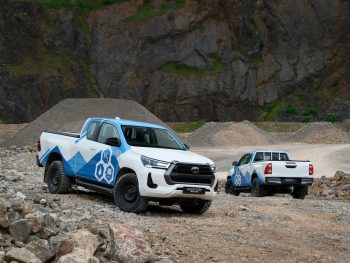Toyota’s project to develop a hydrogen fuel cell Hilux pick-up has stepped up a gear with the start of vehicle testing and evaluations.
 A total of 10 prototype vehicles, powered by Toyota’s fuel cell electric technology and producing no tailpipe emissions, have now been built by Toyota Motor Manufacturing UK and will undergo demonstrations.
A total of 10 prototype vehicles, powered by Toyota’s fuel cell electric technology and producing no tailpipe emissions, have now been built by Toyota Motor Manufacturing UK and will undergo demonstrations.
Five vehicles are undergoing rigorous field testing to assess safety, performance, functionality and durability, generating test drive data in real-world situations.
And a five further units are being used in customer and media demonstrations, including at the forthcoming Olympic and Paralympic Games Paris 2024.
Knowhow from the Hilux project will contribute to the next generation of fuel cell technology, which will offer longer lifecycles, increased driving range for vehicles and significantly reduced costs, backed by Toyota’s 30 years of research and development into hydrogen fuel cells.
The first prototype vehicle was unveiled by Toyota and its consortium partners in September 2023, supported by UK government funding. The prototype uses Toyota’s latest second-generation fuel cell technology already seen in the Mirai saloon to transform the ICE Hilux into a fuel cell electric vehicle that would deliver a much-needed solution to plug a gap in fleet electrification plans.
The fuel cell Hilux retains the same dimensions and appearance as the latest model but incorporates three high-pressure hydrogen fuel tanks, mounted within the ladder frame chassis.
The polymer electrolyte fuel cell stack contains 330 cells and is mounted above the front axle. The fuel cell Hilux is rear-wheel drive via an electric motor on the rear axle which delivers 182hp/134kW of maximum power and 300Nm maximum torque. When driving, the fuel cell produces no tailpipe emissions, only pure water.
The lithium-ion battery, which stores electricity produced on-board by the fuel cell, is positioned in the rear load deck, avoiding loss of cabin space.
The fuel cell Hilux has an expected driving range of up to 600km (372 miles) – further than might be achieved with a battery electric system. Meanwhile, thanks to hydrogen’s light weight, a higher payload and towing capability can be achieved compared to other zero-emission alternatives.
The automaker said the latest phase of the project would pave the way for a successful hydrogen transport sector in the future.
The project reflects Toyota’s wider European strategy to accelerate development of hydrogen fuel cell solutions to deliver carbon neutrality across the region.
Its multi-path strategy applies different powertrain solutions – hybrid electric, plug-in hybrid electric, battery electric, fuel cell electric and e-fuels – to suit different user needs and local infrastructure.
Toyota expects Europe to be one of the largest hydrogen fuel cell markets by 2030, with steady growth in mobility and power generation applications.
As a result, in December 2023 Toyota Motor Europe (TME) announced the Hydrogen Factory Europe, representing Toyota’s co-ordinated approach to the commercialisation of this technology, from development and production to sales and aftersales.
A key element of Toyota’s plan for an expansion in hydrogen usage is the new, third-generation fuel cell technology currently under development, with sales scheduled for 2026-27. These units will deliver a higher power density and an expected 20% increase in driving range. Technical advances and increased production volumes can help to reduce costs by more than a third.
Further research is also looking at the potential of scalable fuel cell stacks with different power outputs and design of fuel tanks with complex shapes, compatible with different size vehicles.
The hydrogen Hilux project is being supported by government funding via the Advanced Propulsion Centre (APC). Consortium partners also include Ricardo, ETL, D2H Advanced Technologies and Thatcham Research.

